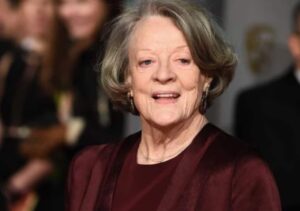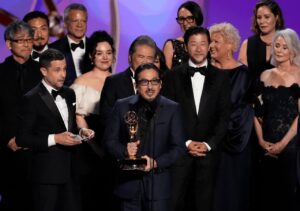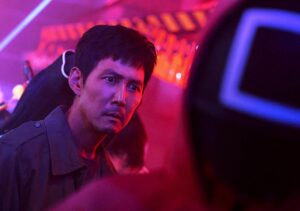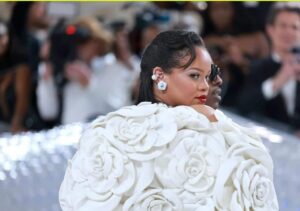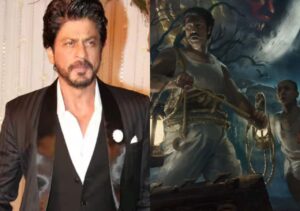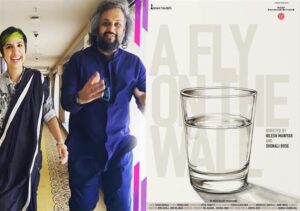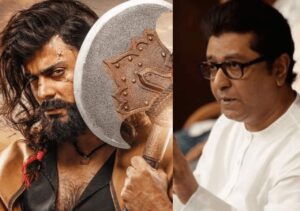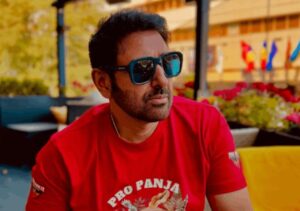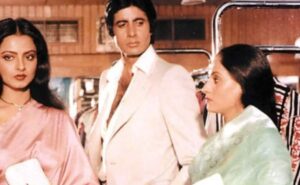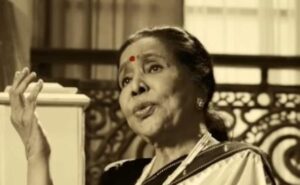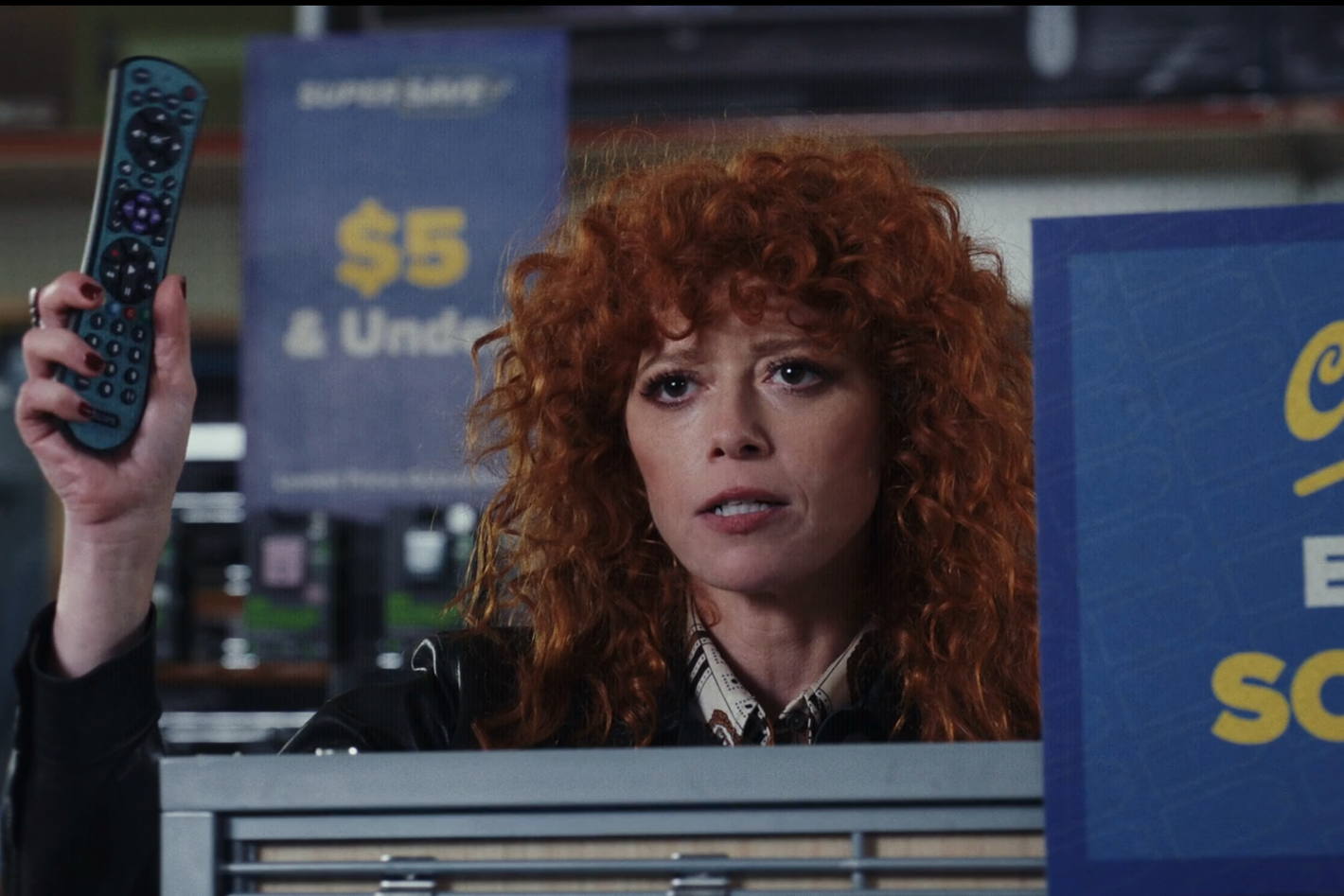
Rare is it that a TV show loves movies as much as Poker Face. It makes sense, since series creator Rian Johnson and star Natasha Lyonne are such cinephiles, that each episode would include a nod or two to various films. But this second season has really amped up the sense that when you’re watching Poker Face, you’re experiencing that viral clip of Vin Diesel praising “the movies.”
Various cult classics, genre favorites, and underseen gems are either directly mentioned or evoked throughout the season’s 12 episodes, and if you’re looking to keep the series’ kooky-criminal vibes going after that cliffhanger finale, they’re a good supplement to your primary Poker Face viewing. So here’s a select list of this season’s many movie references, from overt to winking to possibly imagined, plus some bonus recommendations based on episodic plots and the show’s many, many cameos. Pump up your AC, grab your remote, and invite a good buddy over to cue up this Poker Face–inspired cinematic curriculum.
Note: There are spoilers ahead for the entire second season, including the finale.
Inspired by episode one, “The Game Is a Foot”
The Adventures of Mary-Kate & Ashley (1994–1997), Super Mario Bros. (1993), Cleopatra Jones (1973), Brick (2005), Beavis and Butt-Head Do America (1996)
In this season’s premiere episode, Cynthia Erivo guest stars as five different sisters, four of whom acted together on the TV series Kid Cop: Nights. The Kazinskys’ past as child actresses solving crimes brings to mind the movie series The Adventures of Mary-Kate & Ashley, in which the Olsen twins vowed to solve any crime by dinnertime. Efficient! Erivo’s protagonist, Amber, suffers her mother Norma’s abuse, including when Norma describes her new jumpsuit outfit as making her “look like that little fat plumber in the movies”; Norma means it as an insult, but the wonderfully campy ’90s classic Super Mario Bros. is worth watching for how fully Bob Hoskins commits to playing Mario. Starring with the sisters on their show was actress Tamara Dobson, who anchored the iconic blaxploitation film Cleopatra Jones as the titular model and special agent. Mentioned as Kid Cop’s first love is recurring Rian Johnson collaborator Joseph Gordon-Levitt; if you haven’t seen their neo-noir Brick, in which JGL plays a high-school detective, you should. And finally, Amber’s excessive use of the term “buttmunch” has to be an homage to Beavis and Butt-Head, right? The satirical Beavis and Butt-Head Do America remains delightfully stupid, and it’ll give your brain a break from Poker Face’s many twists and turns.
Inspired by episode two, “Last Looks”
La Bamba (1987), Gloria Bell (2018), Out of the Blue (1980), Slums of Beverly Hills (1998)
This episode stars Giancarlo Esposito and Katie Holmes as Fred and Greta, a mismatched married couple who bicker over nearly everything, but most viciously the 1959 instrumental song “Sleep Walk” by brothers Santo & Johnny Farina. Fred loves it, Greta hates it, and when Lyonne’s Charlie Cale hears Fred listening to the song, she realizes he’s probably responsible for Greta’s disappearance. She’s right! The song’s melancholy quality and its use here to accompany a character’s unexpected death made me think of the similar way the song is used in the film La Bamba; it plays while various characters weep over Ritchie Valens’s airplane crash. Greta’s favorite song, meanwhile, is Anita Ward’s disco classic “Ring My Bell,” and it’s too bad that Greta doesn’t get her own happy ending dancing to the song, as Julianne Moore does in Gloria Bell. Has Charlie seen either of those movies? Unclear, but we know she’s a fan of Dennis Hopper’s Out of the Blue (something she shares with Natasha Lyonne, who helped crowdfund a restoration), an extremely dark and violent drama in which Hopper plays the world’s worst dad. If you thought Hopper was at his scariest in Blue Velvet (or the aforementioned Super Mario Bros.), think again. And if you want another instance of Lyonne and Kevin Corrigan cutting it up together, you can watch them play young lovers in 1998’s Slums of Beverly Hills.
Inspired by episode three, “Whack-a-Mole”
The Departed (2006), Assassins (1990, 2004), Documentary Now! (2019)
If there’s a storyline involving a mole inside a law-enforcement agency, and that mole kills someone the police are investigating because he’s worried that person is going to actually rat him out, then yeah, that’s The Departed. Martin Scorsese, your shadow is long! John Mulaney, Matt Damon … you see the similarities, right? Mulaney has a lot of fun in this episode, especially when he’s defending Stephen Sondheim as the “best lyricist of the 20th century.” The lyrics Mulaney’s FBI agent, Daniel Clyde-Otis, recognizes are from Sondheim’s 1990 musical Assassins, which was restaged on Broadway in 2004 and became a hit. You can listen to the song “Everybody’s Got the Right,” which is specifically mentioned in the episode, or pull up videos of Victor Garber performing in Assassins on YouTube; the latter is particularly great. Yes, I’m deviating from the “movies watchlist” intention of this list, but Garber is always worth it. Also worth breaking this list’s form for: the Documentary Now! episode “Original Cast Album: Co-Op,” in which Mulaney plays a composer named Simon Sawyer, a clear Sondheim analogue. Mulaney’s love for constantly bursting into song on Saturday Night Live is beginning to make more sense!
Inspired by episode four, “The Taste of Human Blood”
The Big Lebowski (1998), Easy Rider (1969), Jay and Silent Bob Strike Back (2001)
What movie better captures the concept of Steve Buscemi as a “good buddy” than The Big Lebowski? And what movie better captures the concept of traveling the country with “no destination … only the highway,” an idea supported by both Charlie and Buscemi’s voice-over on the CB radio, than Easy Rider? Those two films feel like no-brainers after watching “The Taste of Human Blood,” while Jay and Silent Bob Strike Back is admittedly a more galaxy-brained suggestion. But! The animal activists Charlie falls in with in this episode are mostly principled, mostly hot, and mostly willing to let Charlie put her neck out for them in a way she didn’t originally anticipate, all qualities shared with the group Jay and Silent Bob befriend in Kevin Smith’s film. Dogma is having a resurgence; Jay and Silent Bob Strike Back is similarly satirical in that loosey-goosey way Smith does so well.
Inspired by episode five, “Hometown Hero”
Bull Durham (1988), Eephus (2024), Baseball Bugs (1946), Yellow Submarine (1968), Who Framed Roger Rabbit? (1988), Red Rocket (2021)
Charlie mentions binge-watching The Office in this episode, and I can’t begrudge Peacock this moment of cross-promotional synergy, but you do not need to be told to watch The Office — especially when “Hometown Hero” inspires so many alternate viewing choices, baseball movies and otherwise. The episode’s minor-league setting and testy dynamic between a veteran player and a young upstart recall the classic Bull Durham, while the suggestion that the Montgomery Cheesemongers might need to shut down because of their team’s losing streak — which would be a tragedy for the team’s loyal supporters, and the communal experience the team’s games offer — brings to mind the gently wonderful Eephus, about two small-town teams playing their last game on the local field. Charlie Cale’s old-timey striped ballgirl outfit is just one more instance of her channeling the spirit of Bugs Bunny this season, particularly in Baseball Bugs, while the trippy animated sequence she shares with B.J. Novak as the team’s original owner has echoes of Yellow Submarine (his Sgt. Pepper–style outfit) and Who Framed Roger Rabbit? (flying clocks, golden stars, and other inanimate objects given the anthropomorphized treatment). Finally, if Simon Rex being a scumbag is your thing, there’s really no greater example of that than his starring role in Sean Baker’s Red Rocket.
Inspired by episode six, “Sloppy Joseph”
The Omen (1976), Jaws (1975), Inglourious Basterds (2009)
Charlie’s young nemesis Stephanie Pearce is a child of hell, and Eva Jade Halford does the Damien stare like a champ in this episode. For a ’70s doubleheader, pair The Omen with Jaws, given the episode’s direct quoting of “We’re gonna need a bigger boat” from Steven Spielberg’s summer classic. And if watching the class pet Joseph Gerbils get killed was traumatizing for you, counteract that with watching the Nazi mastermind Joseph Goebbels get killed off in Inglourious Basterds. That murder is fun!
Inspired by episode seven, “One Last Job”
Heat (1995), Inside Man (2006), Ocean’s Eleven (2001), Baby Driver (2017), Out of Sight (1998), Miami Vice (2006), Kill Bill Vols. 1 and 2 (2003, 2004), Mission: Impossible — Ghost Protocol (2011), Mission: Impossible — Fallout (2018), Mission: Impossible (1996), Mission: Impossible III (2006), Gone in 60 Seconds (2000), Die Hard (1988), Weekend at Bernie’s (1989), She’s All That (1999), Notting Hill (1999), Bridget Jones’s Diary (2001), Pride & Prejudice (2005)
An episode about a guy who loves movies is going to reference a lot of movies, both in the dialogue and in how the episode is shot, and, well, these are basically all my favorite movies! What a time to feel seen by media! The episode follows Sam Richardson’s aspiring screenwriter, Kendall Hines, who writes a screenplay called One Last Job that is described as having nods to an array of crime-thriller classics, including Michael Mann’s Heat, Spike Lee’s Inside Man, and Steven Soderbergh’s Ocean’s Eleven. Kendall is introduced watching Baby Driver; his apartment is full of movie posters (Soderbergh’s Out of Sight, Mann’s Miami Vice, and Quentin Tarantino’s Kill Bill); and his employee locker code comprises his personal ranking of Mission: Impossible movies (Ghost Protocol, Fallout, the first movie, and Mission: Impossible III). And that’s not all! Gone in 60 Seconds, Die Hard, and Weekend at Bernie’s all get nods, as do an array of films that comprise the episode’s secondary genre fixation: A needle drop of Sixpence None the Richer’s “Kiss Me” is very She’s All That, and the TV in the Indian restaurant where Charlie works cycles through some favorites of of her rom-com-obsessed co-worker, Jenny (Geraldine Viswanathan), including Notting Hill, Bridget Jones’s Diary, and Pride & Prejudice (the Matthew Macfadyen hand-flex version, of course). Episode writer and series EP Taofik Kolade was really on one with the high-spirited, briskly paced “One Last Job,” which makes a case for movies being the “action” in the Heat quote “The action is the juice.”
Inspired by episode eight, “The Sleazy Georgian”
House of Games (1987), The Sting (1973), The Hustler (1961), The Color of Money (1986), Detroit Rock City (1999), Empire Records (1995)
A bunch of con artists hang out at a pool hall with a woman trying to figure out their tells? “The Sleazy Georgian” is broadly shaped like David Mamet’s 1987 neo-noir House of Games, in which a psychiatrist helps her in-debt patient by visiting a pool hall to determine poker players’ tells and then gets mixed up with the con men there. That’s not too different from Charlie befriending the team of con artists led by John Cho. Generally, though, “cool criminals doing stuff in beautifully wood-paneled back rooms” is Paul Newman territory, and the vibes of “The Sleazy Georgian” — especially the sight of Cho in those sunglasses — would pair well with basically any Newman crime picture, but especially The Sting, The Hustler, and The Color of Money, all master classes in movie-star presence. The episode’s other guest stars also inspire a couple viewing suggestions: Longtime friends Melanie Lynskey and Lyonne first met while working on the teen comedy Detroit Rock City (before they worked on another teen comedy, more on that later), and you might recognize Brendan Sexton III from the coming-of-age genre classic Empire Records. It’s nice that Lyonne brought Sexton back after the two worked together on the Netflix series Russian Doll, and there is definitely some of Sexton’s twitchiness as shoplifter Warren in his role here as the shadowy Sketch.
Inspired by episode nine, “A New Lease on Death”
Michael Clayton (2007), The Apartment (1960), Rent Control (2003), Anatomy of a Fall (2023), Kareem Rahma’s digital oeuvre
Do I look like I’m negotiating? I’m not negotiating. Watch Michael Clayton and revel in the glory that is Tony Gilroy’s masterpiece alongside Charlie and her new Clayton-head neighbors, played by Awkwafina and Lauren Tom. After your second to tenth viewing of that, it might be fun to watch some other landlord-related cinema, and you can get a real range of quality with 1960’s The Apartment, a formative example of the romantic comedy, and 2003’s Rent Control, an awful movie with Melissa Joan Hart and Carmen Electra. Each film is hilarious in different ways. “A New Lease on Death” also nods at Anatomy of a Fall, if you want another version of “Isn’t it weird how many fatal maybe-not-accidents occur inside people’s homes?” as entertainment. And in honor of Charlie’s new NYC home — for now — a new-media suggestion inspired by Kareem Rahma’s winking appearance as an awful bro-y buyer: Keep the Meter Running, in which he dines with taxi drivers, and SubwayTakes, which is pretty self-explanatory.
Inspired by episode ten, “The Big Pump”
The Curious Case of Benjamin Button (2008), But I’m a Cheerleader (2000)
Clifford Smith Jr.’s gym owner Brick reverting to acting like a baby as he increasingly drinks breast milk for muscle gains: How can one not think of The Curious Case of Benjamin Button as he clings to Natasha Leggero’s legs and weeps like a toddler throwing a tantrum? One must admire Method Man’s ability to be horrifying and callous in something like The Wire and pathetically moronic here. And with apologies for double-dipping in the “Natasha Lyonne works with her besties” well — this episode is a little light on direct movie nods — I must point out that “The Big Pump” being directed by Clea Duvall means this season of Poker Face has as many reunions of the queer classic But I’m a Cheerleader — which also starred Lynskey — as it does references to Die Hard. That feels right.
Inspired by episode 11, “Day of the Iguana”
The Day of the Jackal (1973), Die Hard (1988), Charlie’s Angels: Full Throttle (2003), Steamboat Willie (1928)
“Day of the Iguana” could not be a more obvious nod to The Day of the Jackal, both in nomenclature and in the focus on the world’s best assassin; given that the assassin is played by Justin Theroux, let’s throw another one of his classic baddie roles in here with Charlie’s Angels: Full Throttle. And although the references to Die Hard (“Yippie ki-yay, oyster shucker”) and classic cartoons via Charlie’s outfits (Steamboat Willie) are a little repetitive, it’s nice that Poker Face has found such specific lanes for itself.
Inspired by episode 12, “The End of the Road”
The Killer (2023), The Godfather Part III (1990), John Wick: Chapter 4 (2023), Jurassic Park (1993), Thelma & Louise (1991), Mission: Impossible — Rogue Nation (2015), Point Break (1991), Five Easy Pieces (1970), The Holdovers (2023)
The end of the season offers a real hodgepodge of movie references to fill your time with before Poker Face returns. (No announcement about whether the series has been renewed yet, but let’s hope so given that cliffhanger ending.) Let’s run through them, starting with Alex’s (Patti Harrison) betrayal of Charlie; she’s actually the world’s best assassin, and she’s been lying to Charlie all along. Alex is great at managing the routine of her job (not unlike Michael Fassbender’s assassin in The Killer) and was almost hired to kill the Pope (hello, The Godfather Part III). When Poker Face tracks her stalking Charlie through mob boss turned FBI informant Beatrix Hasp’s house in an overhead shot, it brings to mind the highly memorable Dragon’s Breath sequence in John Wick: Chapter 4, and Alex calling Charlie a “clever girl” for setting a fire that gets the FBI’s attention is of course a Jurassic Park shout-out. Similarly clear is the freeze-frame of them jumping off a cliff together, à la Thelma & Louise, although unlike that movie, the episode keeps going and both women make it out alive.
But that doesn’t mean Charlie is in the clear for season three. The other major relationship in “The End of the Road” is between Charlie and FBI Agent Luca Clark (Simon Helberg), who until this finale had a pretty good dynamic going in that she helps him solve cases, he gets promoted, and they each go their merry way. But Charlie inadvertently causing Hasp’s death screws up Luca’s big case and makes her an FBI target. She goes from being described as a “force of nature, a crime-solving genius” (like how Ethan Hunt is described as the “living manifestation of destiny” in Mission: Impossible — Rogue Nation) to having the FBI on her tail, with only a brief head start from Luca (they have a Point Break–coded good-bye with Luca as Johnny Utah and Charlie as Bodhi). With her extra time, Charlie accepts a ride from a truck driver (Steve Earle!) to get out of town, in a clear nod to the end of Five Easy Pieces, and as they drive away, the camera lingers on the road, watching the snow gently fall — quite similar to the end of The Holdovers. Until Poker Face comes back, let this watchlist hold you over.
Related
Grab your remote and invite a good buddy over to watch these cult classics, genre favorites, and underseen gems inspired by season two.


